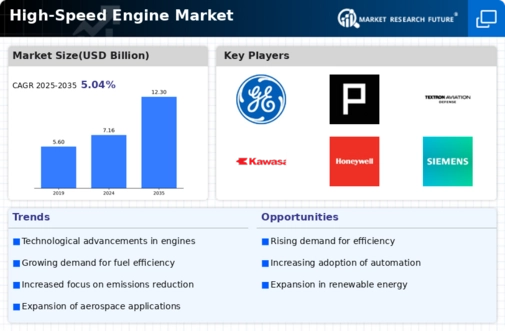Top Industry Leaders in the High Speed Engine Market
*Disclaimer: List of key companies in no particular order
Top listed global companies in the High Speed Engine industry are:
Caterpillar (U.S.)
Cummins (U.S.)
Rolls Royce (U.K.)
Volvo Penta (Sweden)
MAN SE (Germany)
Weichai Power (China)
Wartsila (Finland)
Mitsubishi Heavy Industries (Japan)
Doosan Infracore (South Korea)
Yanmar Holdings (Japan)
Kohler (U.S.)
Deutz (Germany)
Anglo Belgian Corporation (Belgium)
Bridging the Gap by Exploring the Competitive Landscape of the High Speed Engine Top Players
The high-speed engine market, encompassing internal combustion engines operating above 1,000 RPM, showcases a vibrant and dynamic competitive landscape. Established veterans vie for dominance alongside nimble startups, driven by diverse strategies and evolving market trends. Analyzing this landscape demands consideration of key player strategies, market share factors, and emerging trends shaping the industry's future.
Key Player Strategies:
Market Leaders: Renowned players like Rolls-Royce, MAN Energy Solutions, and Wärtsilä leverage their extensive experience, robust global networks, and brand recognition to maintain market leadership. They prioritize research and development (R&D) for fuel efficiency and emission reduction, while simultaneously strengthening after-sales service and forging strategic partnerships. For example, Rolls-Royce's mtu brand collaborates with leading shipbuilders for engine integration and optimization.
Challengers: Companies like Volvo Penta and Cummins focus on specific niches within the market, leveraging cost-effective solutions and regional expertise. Volvo Penta excels in marine propulsion for pleasure crafts and commercial vessels, while Cummins dominates stationary power generation in emerging economies. This targeted approach allows them to gain significant market share within their chosen segments.
Disruptors: Emerging players like AVL List and Ricardo are shaking things up with innovative engine designs and alternative fuels. AVL's focus on high-speed, multi-fuel engines catering to diverse applications, and Ricardo's expertise in hybrid and electric powertrain integration for high-speed applications, position them as potential game-changers.
Market Share Analysis Factors:
Geographical Distribution: The market varies significantly across regions. Europe and North America remain dominant due to established infrastructure and stringent emission regulations, while Asia-Pacific exhibits strong growth propelled by rapid industrialization and maritime trade expansion. Understanding regional dynamics is crucial for market share analysis.
Application Segment: High-speed engines serve diverse needs across power generation, marine propulsion, rail locomotives, oil and gas exploration, and industrial applications. Each segment has distinct requirements and growth trajectories. Companies with strong presence in high-growth segments have an edge.
Technological Prowess: R&D capabilities and adoption of cutting-edge technologies like turbocharging, direct injection, and advanced emissions control systems play a vital role. Players who consistently innovate and deliver high-performance, fuel-efficient engines gain market traction.
New and Emerging Trends:
Sustainability Focus: Stringent emission regulations and rising environmental consciousness push manufacturers towards cleaner technologies. Investments in hybrid and electric powertrain integration, alternative fuels like hydrogen and biofuels, and optimization for reduced emissions are gaining momentum.
Digitalization and Automation: Integration of sensors, artificial intelligence, and advanced data analytics enables real-time engine monitoring, predictive maintenance, and remote engine diagnostics. This improves operational efficiency, reduces downtime, and enhances customer service, becoming a critical differentiator.
Modular Design and Customization: Manufacturers are increasingly offering modular engine platforms with the flexibility for customization based on specific customer needs. This personalized approach caters to diverse application requirements and fosters stronger customer relationships.
Overall Competitive Scenario:
The high-speed engine market is characterized by intense competition, constant innovation, and evolving customer demands. While established players hold significant sway, niche players and disruptors with innovative solutions and targeted approaches pose a growing threat. The ability to adapt to changing regulations, embrace new technologies, and offer sustainable, cost-effective solutions will determine success in this dynamic landscape. The companies that navigate these trends effectively and cultivate strong customer partnerships stand to claim a larger share of the ever-expanding high-speed engine market.
Latest Company Updates:
Caterpillar (U.S.)
- November 2023: Unveiled the Cat C3.6 high-speed diesel engine for marine applications, featuring improved fuel efficiency and emissions reduction. (Source: Caterpillar press release)
Cummins (U.S.)
- January 2024: Introduced the QSX15L natural gas engine for stationary power generation, offering low emissions and high efficiency. (Source: Cummins press release)
Rolls-Royce (U.K.)
- October 2023: Completed successful testing of the MTU Series 1600 high-speed engine running on 100% hydrogen fuel. (Source: Rolls-Royce press release)
Volvo Penta (Sweden)
- January 2024: Unveiled the TWD1675 diesel engine for heavy-duty marine applications, delivering high power and improved fuel economy. (Source: Volvo Penta press release)
MAN SE (Germany)
- October 2023: Signed a contract to supply MAN 18V51/60 engines for a new power plant in Indonesia, highlighting the engine's high efficiency and low emissions. (Source: MAN Energy Solutions press release)

